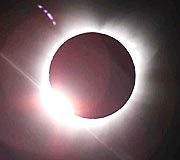Rare annular eclipse to cross Europe, Africa
Oct 2, 2005 (LISBON) — A rare and spectacular type of eclipse will dim the morning sky across a strip of southwestern Europe and eight African countries Monday.
 During the event, called an annular eclipse, the moon will mask the sun like a black plate, leaving a bright, fiery rim.
During the event, called an annular eclipse, the moon will mask the sun like a black plate, leaving a bright, fiery rim.
The moon will be too small to blot out the sun completely, as in a total eclipse, because its elliptical orbit has taken it too far from the earth.
However, scientists say the daylight will fade and temperatures will drop slightly as the eclipse travels along a narrow band girdling almost half the planet.
The rim of fire that appears around the moon glows brighter than the corona which is seen during a total eclipse.
“It’s quite spectacular,” said Dr. Stephen Maran, an astronomer with the American Astrological Society in Washington DC.
“I wouldn’t miss it if I was over there, because it’s rare,” Maran said by telephone.
The eclipse’s three-and-a-half-hour path first traverses Portugal and Spain, including the capital, Madrid.
The Iberian peninsula hasn’t witnessed an annular eclipse since 1912 and won’t see another one until 2028.
The eclipse’s narrow corridor will also travel across mostly deserted parts of Africa, encompassing Algeria, Tunisia, Libya, Chad, Sudan, Ethiopia, Kenya and Somalia.
Outside that band, a partial eclipse will be visible through protective eyewear over most of Europe, the Middle East, India and a large chunk of Africa, though some cloud cover is forecast on that continent.
Authorities are reminding the public to avoid looking at the sun without eye protection.
In Spain, where the event has stirred keen anticipation, opticians selling 1 million special protective glasses at A3 ($3.70) each said Friday they had virtually sold out.
In Portugal, the General Directorate for Health was distributing free glasses with daily papers.
The annular eclipse starts over the North Atlantic at 0841 GMT. It quickly tracks southeast, crossing the Iberian peninsula. At 0856 GMT, the eclipse will blanket Madrid for 4 minutes, 11 seconds.
It then crosses the Mediterranean into North Africa, covering the Algerian capital, Algiers.
At 1031 GMT central Sudan will experience the event’s longest eclipse, lasting 4 minutes, 31 seconds.
The eclipse passes over the coast of southern Somalia at 1110 GMT and concludes at sunset over the Indian Ocean at 1220 GMT.
_
On the Net:
NASA eclipse site: http://sunearth.gsfc.nasa.gov/eclipse/SEmono/ASE2005/ASE2005.html
